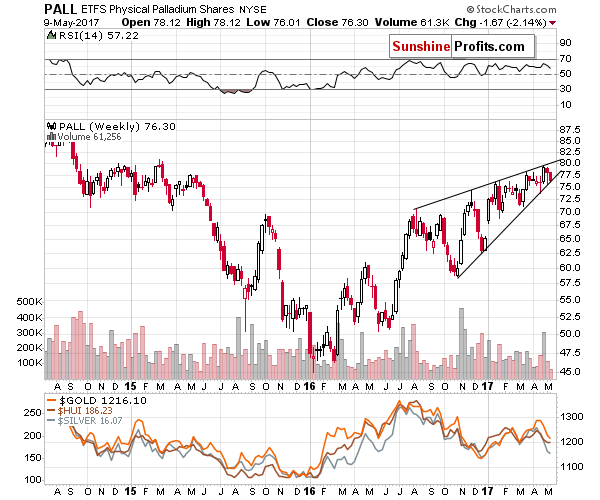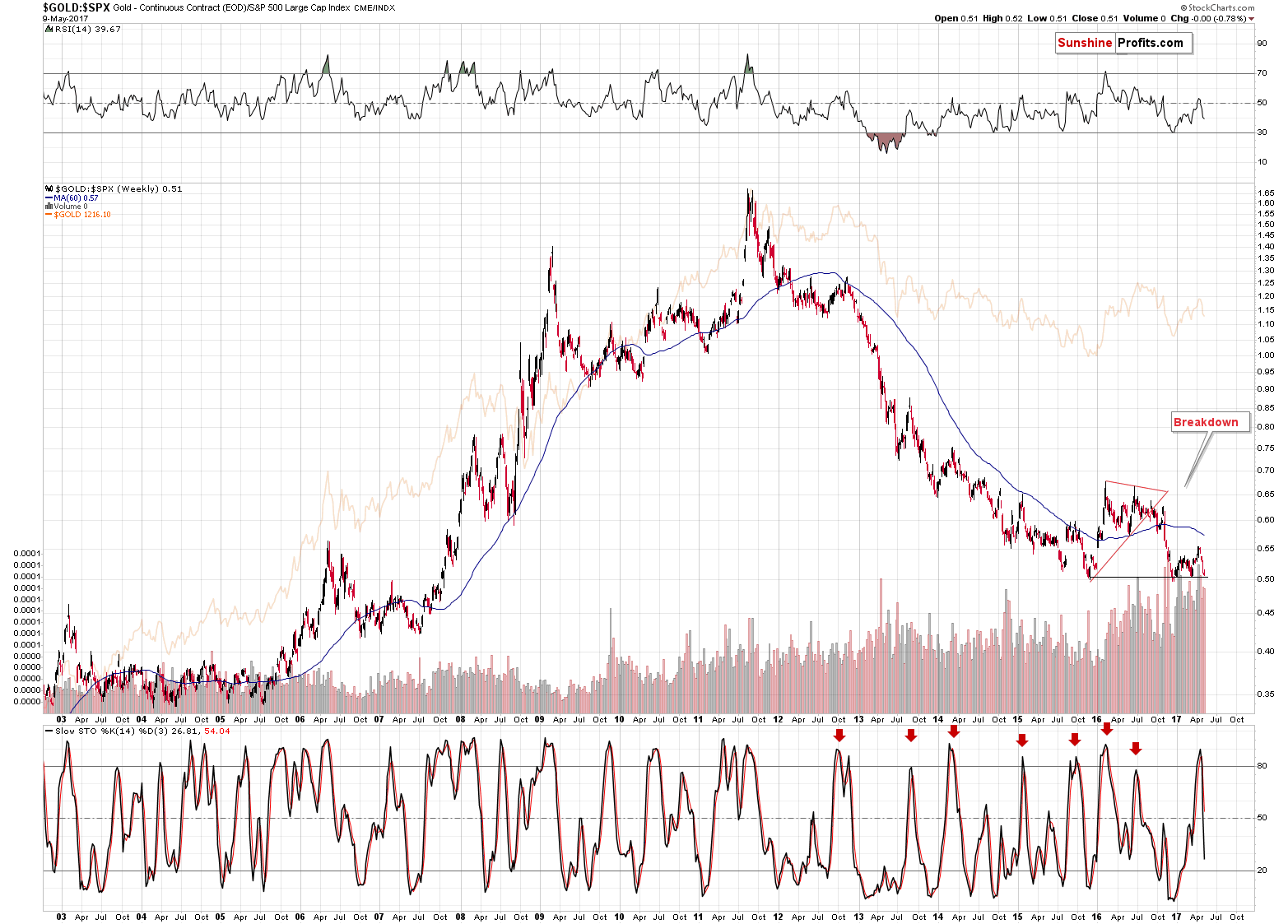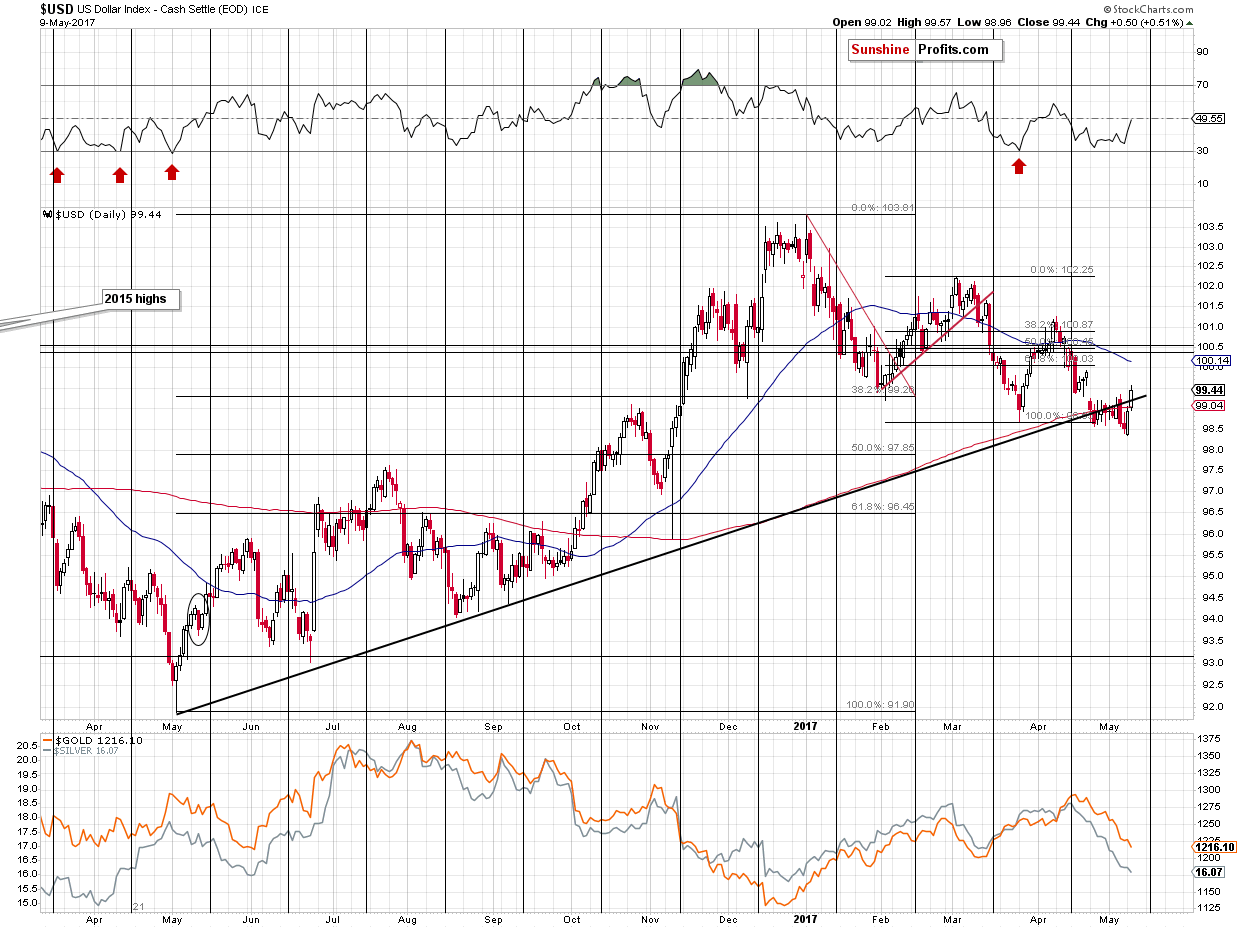Briefly: In our opinion, full (150% of the regular full position) speculative short positions in gold, silver and mining stocks are justified from the risk/reward perspective at the moment of publishing this alert.
In yesterday’s alert, we discussed a development that was likely to substantially increase the volatility in the precious metals sector. Based on yesterday’s session, it became even more likely that this would take place shortly. Will gold really plunge in the following weeks even though it has already fallen quite visibly?
Probably yes. The development that we discussed in yesterday’s alert was a huge rising wedge pattern in the palladium market that was likely to contribute to much lower precious metals prices in the coming weeks. The thing that changed yesterday is that the price of platinum moved to the lower border of the pattern. Let’s take a look at the chart (charts courtesy of http://stockcharts.com).

The palladium price is now right at the lower border of the rising wedge, which means that if the decline continues, we’ll see a breakdown shortly and the implications will be much more bearish than they are today.
Does is matter that gold and silver have already declined substantially? Not really – if we were betting on a short-term move, then the length of the recent decline would be a factor, as one could look for a rebound simply based on the fact that the size of the decline was similar to the previous declines. We are not betting on a short-term move here, but on a major, medium-term one.
At this time one may ask why we are betting on a medium-term move instead of short-term ones. The reason is that this is the term that provides us with the best risk to reward ratio at this time. The situation in the USD Index is extremely bullish for the following months, but it is not as clear (and it’s not been as clear for months) for the short term. The same goes for many other factors that are currently in play. Even if we want to make more trades, we still have to start with what the market gives us. Otherwise, we would be entering trades with weak risk-to-reward situations, which would be likely to lead to many losses. If the market provides us with an opportunity to trade for the short term, we will do exactly that.
The price of palladium is not the only thing on the verge of a major breakdown that is likely to send precious metals much lower.

The gold-to-S&P500 ratio is also almost right at the previous 2017, 2016 and 2015 lows. Just a bit more weakness in gold relative to the stock market and the ratio breaks lower. Please note that the ratio was quite often early to indicate major moves in gold itself, so a breakdown here below multi-year lows would be an extremely important sign pointing to lower precious metals prices in the coming weeks and months.

The trigger for the above was likely already seen, even though it seems that most market participants are still not paying attention to it.
The USD Index invalidated its breakdown below the rising medium-term support line, by showing strength in tune with its True Seasonal patterns – just like we described it on Monday. The outlook is clearly bullish, however, it could still be the case that traders are not viewing the USD’s strength as something serious as they are usually focused on the short-term term trends and most recent developments. In this case, it means that its likely that they focus on the fact that the USD has been forming lower highs and lower lows so far this year and thus the trend remains down. In our opinion, the long-term chart provides much more meaningful signals than the above, so we can expect that the mentioned short-term downtrend will be reversed and when that happens we can expect precious metals traders to catch up with their reaction to the USD’s strength.
Summing up, gold and silver declined once again yesterday, but the most important developments took place one less known charts: the ones featuring the price of palladium and the gold-to-S&P500 ratio. Both are now on the verge of breakdowns that will likely have profound and bearish implications for the entire PM sector. As always, we will keep you – our subscribers – informed.
To summarize:
Trading capital (supplementary part of the portfolio; our opinion): Short positions (150% of the full position) in gold, silver and mining stocks are justified from the risk/reward perspective with the following stop-loss orders and initial target price levels / profit-take orders:
- Gold: exit-profit-take level: $1,063; stop-loss: $1,317; initial target price for the DGLD ETN: $81.88; stop-loss for the DGLD ETN $44.57
- Silver: initial target price: $13.12; stop-loss: $19.22; initial target price for the DSLV ETN: $46.18; stop-loss for the DSLV ETN $17.93
- Mining stocks (price levels for the GDX ETF): initial target price: $9.34; stop-loss: $26.34; initial target price for the DUST ETF: $143.56; stop-loss for the DUST ETF $21.37
In case one wants to bet on junior mining stocks' prices (we do not suggest doing so – we think senior mining stocks are more predictable in the case of short-term trades – if one wants to do it anyway, we provide the details), here are the stop-loss details and initial target prices:
- GDXJ ETF: initial target price: $14.13; stop-loss: $45.31
- JDST ETF: initial target price: $417.04; stop-loss: $43.12
Long-term capital (core part of the portfolio; our opinion): No positions (in other words: cash)
Insurance capital (core part of the portfolio; our opinion): Full position
Please note that the in the trading section we describe the situation for the day that the alert is posted. In other words, it we are writing about a speculative position, it means that it is up-to-date on the day it was posted. We are also featuring the initial target prices, so that you can decide whether keeping a position on a given day is something that is in tune with your approach (some moves are too small for medium-term traders and some might appear too big for day-traders).
Plus, you might want to read why our stop-loss orders are usually relatively far from the current price.
Please note that a full position doesn’t mean using all of the capital for a given trade. You will find details on our thoughts on gold portfolio structuring in the Key Insights section on our website.
As a reminder – “initial target price” means exactly that – an “initial” one, it’s not a price level at which we suggest closing positions. If this becomes the case (like it did in the previous trade) we will refer to these levels as levels of exit orders (exactly as we’ve done previously). Stop-loss levels, however, are naturally not “initial”, but something that, in our opinion, might be entered as an order.
Since it is impossible to synchronize target prices and stop-loss levels for all the ETFs and ETNs with the main markets that we provide these levels for (gold, silver and mining stocks – the GDX ETF), the stop-loss levels and target prices for other ETNs and ETF (among other: UGLD, DGLD, USLV, DSLV, NUGT, DUST, JNUG, JDST) are provided as supplementary, and not as “final”. This means that if a stop-loss or a target level is reached for any of the “additional instruments” (DGLD for instance), but not for the “main instrument” (gold in this case), we will view positions in both gold and DGLD as still open and the stop-loss for DGLD would have to be moved lower. On the other hand, if gold moves to a stop-loss level but DGLD doesn’t, then we will view both positions (in gold and DGLD) as closed. In other words, since it’s not possible to be 100% certain that each related instrument moves to a given level when the underlying instrument does, we can’t provide levels that would be binding. The levels that we do provide are our best estimate of the levels that will correspond to the levels in the underlying assets, but it will be the underlying assets that one will need to focus on regarding the signs pointing to closing a given position or keeping it open. We might adjust the levels in the “additional instruments” without adjusting the levels in the “main instruments”, which will simply mean that we have improved our estimation of these levels, not that we changed our outlook on the markets. We are already working on a tool that would update these levels on a daily basis for the most popular ETFs, ETNs and individual mining stocks.
Our preferred ways to invest in and to trade gold along with the reasoning can be found in the how to buy gold section. Additionally, our preferred ETFs and ETNs can be found in our Gold & Silver ETF Ranking.
As always, we'll keep you - our subscribers - updated should our views on the market change. We will continue to send out Gold & Silver Trading Alerts on each trading day and we will send additional Alerts whenever appropriate.
The trading position presented above is the netted version of positions based on subjective signals (opinion) from your Editor, and the Tools and Indicators.
As a reminder, Gold & Silver Trading Alerts are posted before or on each trading day (we usually post them before the opening bell, but we don't promise doing that each day). If there's anything urgent, we will send you an additional small alert before posting the main one.
=====
Latest Free Trading Alerts:
Last week, the World Gold Council published a new edition of its quarterly report on gold demand. What does Gold Demand Trends Q1 2017 say about the demand for gold in the first quarter of 2017?
=====
Hand-picked precious-metals-related links:
PRECIOUS-Gold edges off 8-week low as Comey firing weighs on risk appetite
Gold Imports by India Said to Rise More Than Four-Fold in April
Silver Bar & Coin Demand Sinks in 'Saturated' US
=====
In other news:
Stock Futures Fall After Trump Axes FBI Director Comey
Pimco to BlackRock Pile Into `Fragile Five' Post-Taper Tantrum
It's not just stocks—there's a very weird calm affecting trading across financial markets
=====
Thank you.
Sincerely,
Przemyslaw Radomski, CFA
Founder, Editor-in-chief, Gold & Silver Fund Manager
Gold & Silver Trading Alerts
Forex Trading Alerts
Oil Investment Updates
Oil Trading Alerts



